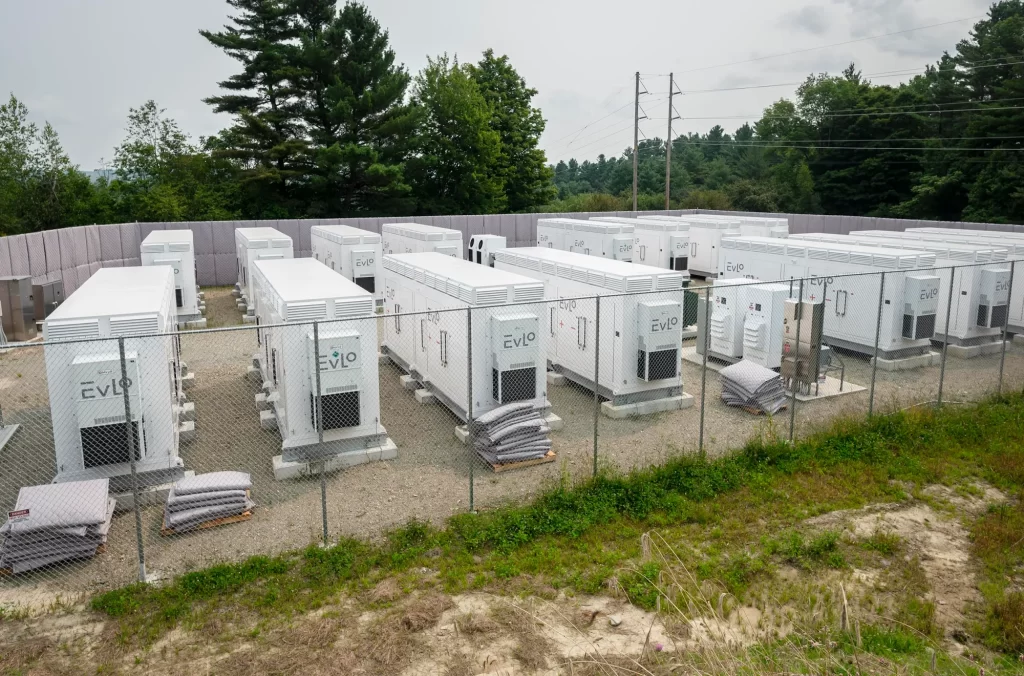
Operators cut the ribbon on Friday for a new utility-scale battery, which is expected to keep renewable energy projects in the area running more consistently while reducing strain on the electrical grid during peak usage times.
Sixteen white blocks, roughly the size of shipping containers, hummed quietly on Friday as members of Vermont Electric Cooperative, the U.S. Department of Energy and other partners announced the project’s completion. It’s expected to come online in the next several weeks after a yearslong process that began in 2021.
The 3-megawatt battery can store enough energy to power 600 homes for a full day, according to Kristin Carlson, a spokesperson for Green Mountain Power, which will own and operate the project jointly with Vermont Electric Cooperative.
The battery is located in “a really unique spot in the grid” called the Sheffield-Highgate Export Interface, where sometimes there is “more renewable energy produced than we have capacity to either use locally, or to export on transmission lines,” said Rebecca Towne, chief executive officer at Vermont Electric Cooperative.
What happens then, she said, is that local renewable energy projects, such as Kingdom Community Wind — a controversial project along the Lowell Mountains that was completed in 2012 — have to power down or reduce the amount of energy they generate. In essence, a lack of capacity can kick renewable energy off the grid.
The new battery changes the equation, keeping the energy stored until it’s needed.
“It’s an indicator of a problem that we expect to see on the grid, not only in other places in Vermont, but around the country,” Towne said. “And so figuring out solutions that help resolve that problem is critical as we make that transition to our energy future.”
When utilities aren’t using the battery to keep local renewables running or drawing on the energy stored there to manage peak energy demand, Green Mountain Power plans to make the stored power available to the regional grid operator, ISO New England, which will use it to “balance the grid on a regular basis,” Towne said.
Operators expect the battery to be fully up and running in the next several weeks. It already completed a test run during a July heat wave, when energy demand rose to its highest so far this year, Towne said.
“We have been able to test it and got some value in real-life conditions, which has been great,” she said. “And we also discovered, like you often do with complex projects, there’s some things to tweak and improve, and that’s what the team has been working on since then.”
The Department of Energy funneled $2 million toward the roughly $5 million project, and Vermont Electric Cooperative and Green Mountain Power plan to split the remaining costs.
The battery was produced by EVLO Energy Storage, a Montreal-based company and subsidiary of Hydro-Quebec. The batteries contain several redundant safety features, including smoke detectors and hydrogen sensors.
“In case of an emergency, if there’s some gas or some fire or whatever, traps will open, and even if you don’t have power, just with air, natural convection, it will cool the system,” said Vincent David, vice president of deployment and operations at EVLO. “We don’t need to circulate liquid to cool the system. It’s naturally vented, so the system can be cooled without any power.”
Utility-scale batteries are becoming more common in Vermont. Green Mountain Power has already deployed six utility-scale batteries in Georgia, Springfield, Bethel, Middlebury, Bristol and Barre. Together with residential batteries placed in customer homes, the utility has a total of 68.5 megawatts of battery storage across the state.
As the United States races to address climate change, federal, state and local governments are working to increase reliance on renewable energy sources and decrease reliance on fossil fuels.
When people burn, produce and transport fossil fuels, pollutants like carbon dioxide and methane enter the atmosphere and trap the sun’s heat, which warms the ocean and atmosphere and creates more extreme weather, such as flooding and heat waves in Vermont.
In Vermont, lawmakers recently passed an update to the state’s renewable energy standard, which increases the amount of renewable energy that local utilities must purchase over time.
But in a state that’s typically cloudy and snow-covered for much of the year, deploying more renewable energy can be tricky. Utilities and renewable energy advocates see battery storage as an important part of increasing Vermont’s reliance on renewables.
“When it comes to expanding renewable energy in Vermont, storage is key because you need to be able to deliver power 24/7, reliably, to customers,” Carlson said.
Vermont Electric Cooperative owns another 1-megawatt battery in Hinesburg and plans to deploy another utility-scale project in South Hero, the details of which haven’t been fully decided, according to Towne.
Imre Gyuk, chief scientist of energy storage research at the Department of Energy, said he worked with Green Mountain Power several years ago to create a pioneering battery storage system in Vermont.
“Vermont is now becoming famous for it,” he said. Because the project is designed to keep local renewable energy running consistently, “this is yet another project which is essentially the first of its kind.”
























